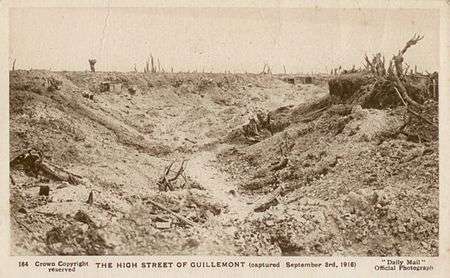Guillemont
| Guillemont | |
|---|---|
 Guillemont | |
|
Location within Hauts-de-France region  Guillemont | |
| Coordinates: 50°00′52″N 2°49′33″E / 50.0144°N 2.8258°ECoordinates: 50°00′52″N 2°49′33″E / 50.0144°N 2.8258°E | |
| Country | France |
| Region | Hauts-de-France |
| Department | Somme |
| Arrondissement | Péronne |
| Canton | Combles |
| Intercommunality | Canton of Combles |
| Government | |
| • Mayor (2008–2014) | Didier Samain |
| Area1 | 3.27 km2 (1.26 sq mi) |
| Population (2006)2 | 124 |
| • Density | 38/km2 (98/sq mi) |
| Time zone | CET (UTC+1) |
| • Summer (DST) | CEST (UTC+2) |
| INSEE/Postal code | 80401 / 80360 |
| Elevation |
94–156 m (308–512 ft) (avg. 138 m or 453 ft) |
|
1 French Land Register data, which excludes lakes, ponds, glaciers > 1 km² (0.386 sq mi or 247 acres) and river estuaries. 2 Population without double counting: residents of multiple communes (e.g., students and military personnel) only counted once. | |
Guillemont is a commune roughly 13 km (8.1 mi) east of Albert in the Somme department in Hauts-de-France in northern France.
It, like much of the surrounding area, is primarily an agricultural community, but is known for its large cemetery, which has become a tourist attraction. The cemetery began as a field graveyard after the Battle of Guillemont, but was quickly expanded after the Armistice when graves from surrounding areas were centralized here.

In World War I, Guillemont was one of several important strategic areas controlled by Germans that effectively divided allied forces. It was exchanged several times during the war, before being finally taken and held by the British 20th (Light) Division and the 47th Brigade of the 16th (Irish) Division.
See also
References
External links
| Wikimedia Commons has media related to Guillemont. |